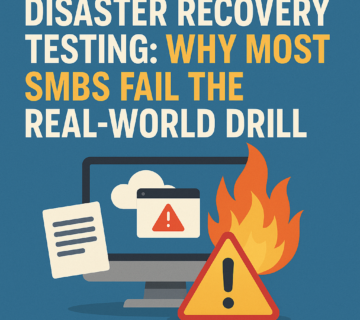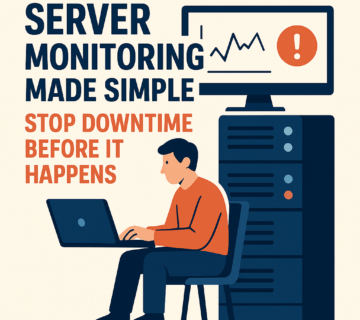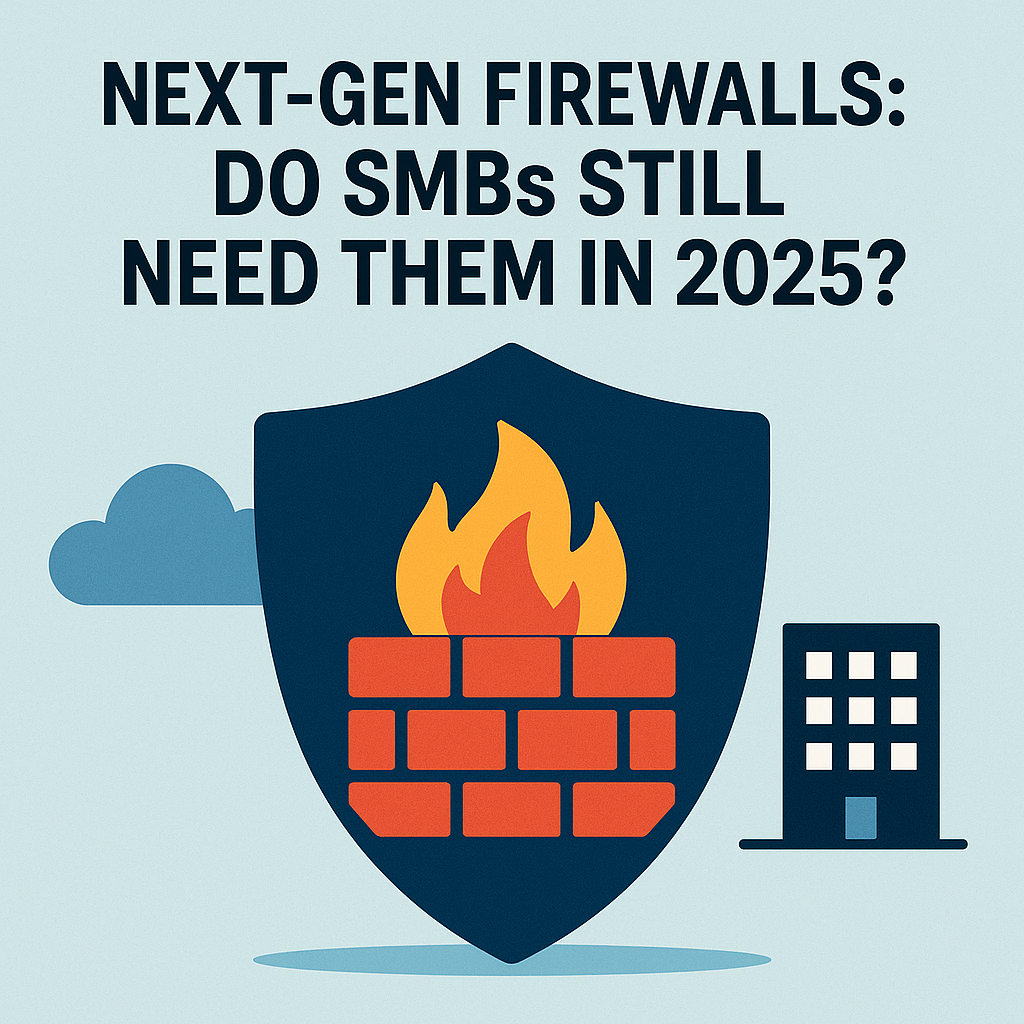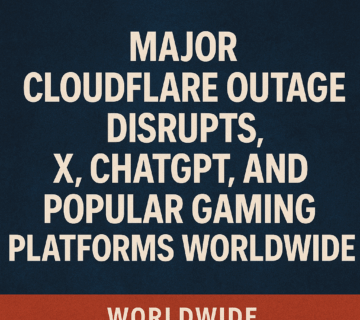Cloudflare Discloses Technical Details Behind Massive Outage That Broke the Internet
🎙️ Dive Deeper with Our Podcast!
Cloudflare Outage: Cause, Impact, and Resilience Strategy
The internet experienced a significant disruption on November 19, 2025, when Cloudflare—one of the world’s largest content delivery networks—suffered a major service failure that impacted millions of users globally. What started as a routine security enhancement spiraled into one of the company’s worst outages since 2019, leaving websites inaccessible and critical services offline for nearly six hours. This event underscores a stark reality: even top-tier cloud infrastructure providers are not immune to operational missteps, and organizations must be ready to respond accordingly.
Understanding the Cloudflare Outage: What Happened?
The disruption began at 11:20 UTC when Cloudflare’s network infrastructure started experiencing widespread failures. Unlike typical cybersecurity incidents involving external threat actors, this outage originated from an internal configuration change that went wrong. The problem affected core services that millions of websites and applications depend on daily, creating a ripple effect across the internet.
Cloudflare protects and accelerates countless websites, from small businesses to Fortune 500 companies. When their infrastructure falters, the impact reverberates throughout the digital economy. Organizations in Orange County and across Southern California that rely on Cloudflare-protected services found themselves unable to serve customers, process transactions, or maintain operations during the outage window.
The incident particularly impacted businesses during peak operational hours, highlighting how dependent modern commerce has become on cloud service providers. For small and medium-sized businesses without redundant infrastructure, such disruptions can translate directly into revenue loss and customer frustration.
The Technical Root Cause: A Configuration Change Gone Wrong
The outage traced back to a seemingly innocuous update made at 11:05 UTC to Cloudflare’s ClickHouse database cluster. Engineers implemented a permissions change designed to improve security for distributed queries across their infrastructure. However, this change unintentionally made internal table metadata from a database named “r0” visible to user-facing queries. A Bot Management query then pulled duplicate column data, causing a critical feature file to balloon to twice its expected size. This file, which refreshes every five minutes to help machine learning systems identify and block malicious bot traffic, exceeded the software’s hardcoded limit of 200 features. The oversized file triggered system panics in Cloudflare’s core proxy system, known as FL, which handles the actual routing and processing of internet traffic.
What made diagnosis particularly challenging was that good and bad versions of the file alternated during the cluster’s gradual rollout process. Engineers initially suspected a distributed denial-of-service attack, especially since Cloudflare’s external status page also went offline simultaneously. This coincidence delayed proper identification of the root cause, extending the outage duration.
The Bot Management module, essential for distinguishing legitimate users from automated threats, stopped processing requests correctly. In Cloudflare’s newer FL2 proxy system, this failure resulted in direct 5xx HTTP errors that users saw as service unavailable messages. Older FL versions responded differently, defaulting bot scores to zero—a behavior that potentially blocked legitimate traffic for customers using bot-blocking security rules.
Cascading Impact Across Cloudflare Services
The configuration error didn’t just affect website availability. The failure cascaded through multiple interconnected services within Cloudflare’s ecosystem, creating compounding problems for users and administrators.
Turnstile, Cloudflare’s CAPTCHA alternative used for authentication and bot detection, failed completely. This prevented legitimate users from logging into protected applications and websites, essentially locking customers out of their own systems. For businesses using Cloudflare Access for identity and access management, the outage meant employees couldn’t authenticate to critical applications.
Workers KV, Cloudflare’s edge storage service, experienced elevated error rates. Since the Cloudflare dashboard itself relies on Workers KV, administrators couldn’t even access their control panels to assess the situation or implement workarounds. This created a frustrating scenario where customers had no visibility into the problems affecting their services.
Email Security services temporarily lost some spam detection capabilities, though Cloudflare confirmed no significant customer data was compromised. Configuration updates across the platform experienced delays, preventing customers from making changes to their settings during the crisis period.
Resource-intensive debugging efforts during the incident further increased latency across the network. Users accessing Cloudflare-protected sites encountered error pages, slow load times, or complete unavailability. By 17:06 UTC, nearly six hours after the initial failure, Cloudflare achieved full recovery by halting propagation of the corrupted file, rolling back to a known-good configuration version, and systematically restarting affected proxy systems.
A Troubling Pattern Among Cloud Giants
Cloudflare’s November outage doesn’t exist in isolation—it represents part of a concerning trend among major cloud infrastructure providers experiencing significant failures due to configuration and operational issues.
Just weeks earlier on October 29, 2025, Microsoft Azure suffered a global outage stemming from a problematic tenant change in its Front Door content delivery network. That incident disrupted Microsoft 365, Teams, and Xbox services for hours, with ripple effects impacting airlines like Alaska Airlines that depend on Azure-hosted systems.
Amazon Web Services encountered its own major disruption on October 20 in the critical US-East-1 region. DNS configuration issues in DynamoDB created a 15-hour blackout that affected EC2, S3, and numerous dependent services including Snapchat and Roblox. A smaller AWS incident on November 5 impacted Amazon.com’s e-commerce platform, stalling checkouts during the crucial holiday shopping preparation period.
These recurring incidents across different providers point to systemic challenges in managing increasingly complex cloud infrastructures. As these platforms scale to handle global traffic, the interconnections between services multiply, creating more potential points of failure. A single configuration error in one component can trigger cascading failures throughout the ecosystem.
Cybersecurity and infrastructure experts warn that businesses are developing dangerous over-dependence on centralized cloud providers. When single vendors control such significant portions of internet infrastructure, individual mistakes can literally “break the internet” for millions of users. The frequency of these major outages in 2025 suggests that operational precision hasn’t kept pace with infrastructure growth.
Business Continuity Implications for Orange County Companies
For businesses throughout Orange County and Southern California, these outages underscore critical vulnerabilities in modern IT infrastructure strategies. Many organizations have migrated entirely to cloud-based services without implementing adequate redundancy or contingency plans. When a provider like Cloudflare, Azure, or AWS experiences downtime, businesses can find themselves completely unable to operate.
Small and medium-sized businesses face particular risk because they typically lack the resources to implement multi-cloud strategies or maintain on-premises backup systems. A six-hour outage during business hours can mean lost sales, missed appointments, damaged reputation, and frustrated customers who may turn to competitors.
The financial impact extends beyond immediate revenue loss. Staff productivity plummets when cloud-dependent tools become unavailable. Customer service teams face increased call volumes from confused clients. Marketing campaigns fail to deliver. Remote workers can’t access necessary applications. These compounding effects make even “brief” outages surprisingly costly.
Moreover, businesses may face compliance and contractual obligations requiring certain uptime guarantees. When cloud provider failures prevent meeting these commitments, organizations bear the consequences even though the root cause originated outside their direct control.
Cloudflare’s Response and Prevention Measures
Cloudflare CEO Matthew Prince issued a public apology, describing the incident as “deeply painful” and unacceptable for a company positioned as a critical internet infrastructure provider. The company acknowledged this as their worst core traffic outage since 2019, demonstrating transparency about the severity of the failure.
The company outlined several technical improvements to prevent similar incidents. They are enhancing their file-ingestion workflows to identify and block malformed inputs before those files ever reach production systems. Global kill switches are being implemented to allow rapid disabling of problematic features without requiring full system restarts.
Cloudflare is also addressing the overwhelming volume of error reports that complicated diagnosis during the outage. By improving telemetry and alerting systems, engineers should be able to identify root causes more quickly in future incidents. The company is conducting comprehensive reviews of proxy failure modes to ensure degraded operation rather than complete failures when issues occur.
These improvements represent important steps, but they also highlight how complex modern cloud infrastructure has become. Even with extensive monitoring, testing, and operational procedures, a single configuration change can trigger unexpected cascading failures.
Building Resilient IT Infrastructure for Your Business
The Cloudflare outage and similar incidents at other major providers offer important lessons for businesses designing resilient IT strategies. Relying exclusively on any single cloud provider, regardless of their reputation or size, introduces unacceptable risk for mission-critical operations.
Organizations should evaluate multi-cloud approaches that distribute critical services across different providers. While this adds complexity and cost, it prevents single points of failure from completely disabling business operations. For example, hosting your primary website on one platform while maintaining authentication services on another ensures that a provider-specific outage doesn’t eliminate all customer touchpoints simultaneously.
Implementing proper monitoring and alerting systems helps businesses detect provider issues quickly and activate contingency plans. Many companies only discovered the Cloudflare outage when customers complained—a reactive approach that extends downtime and damages reputation. Proactive monitoring enables faster response and clearer customer communication.
Documentation of critical dependencies and recovery procedures ensures teams can respond effectively during crises. When cloud services fail, staff members need clear guidance on alternative processes, communication protocols, and escalation paths. Without documented plans, organizations waste precious time during outages determining how to respond.
Regular testing of disaster recovery and business continuity plans validates that backup systems and procedures actually work when needed. Many businesses maintain backup infrastructure that has never been properly tested, only to discover during actual outages that their contingency plans are inadequate or outdated.
The Growing Importance of Managed IT Services
As cloud infrastructure grows more complex and interdependent, businesses increasingly recognize they lack internal expertise to properly design, implement, and maintain resilient IT environments. The technical knowledge required to evaluate cloud providers, implement multi-cloud strategies, configure proper monitoring, and respond to incidents has become a specialized skill set.
Managed IT service providers bring expertise across multiple platforms and technologies, helping businesses navigate the complex cloud landscape. Rather than depending entirely on self-service cloud platforms, organizations benefit from professional guidance on architecture decisions, security configurations, and operational best practices.
Managed services also provide the monitoring and response capabilities that most businesses cannot cost-effectively maintain in-house. When provider outages occur, managed IT teams can quickly assess impact, implement workarounds, and communicate with stakeholders. This professional response minimizes downtime and its associated costs.
For businesses focused on their core competencies rather than IT operations, partnering with experienced managed service providers makes strategic sense. The investment in professional IT management typically proves far less expensive than the costs associated with major outages, security incidents, or misconfigurations.
Frequently Asked Questions
What caused the Cloudflare outage on November 19, 2025?
The outage resulted from an internal configuration change to Cloudflare’s ClickHouse database cluster. A permissions update intended to enhance security inadvertently exposed table metadata, causing a Bot Management query to pull duplicate data. This bloated a critical feature file beyond system limits, triggering failures in Cloudflare’s core proxy infrastructure. The issue stemmed from an internal operational mistake, not from any outside cyberattack.
How long did the Cloudflare outage last?
The service disruption began at 11:20 UTC and lasted approximately six hours, with full recovery achieved at 17:06 UTC. During this period, various Cloudflare services experienced different levels of degradation, from complete unavailability to intermittent errors. Some services like Turnstile CAPTCHA failed entirely, while others like Email Security experienced partial capability loss.
Were other major cloud providers affected by similar issues recently?
Yes, both Microsoft Azure and Amazon Web Services experienced significant outages in October and November 2025. Azure suffered a global disruption on October 29 due to a Front Door CDN configuration error. AWS experienced a 15-hour outage in its US-East-1 region on October 20 from DNS issues in DynamoDB, and another incident affecting Amazon.com on November 5. These events underscore the broader, industry-wide difficulties that major cloud providers face in managing configurations effectively.
What services were impacted during the Cloudflare outage?
The outage affected multiple Cloudflare services including core website protection and acceleration, Turnstile CAPTCHA authentication, Workers KV storage, Cloudflare Access identity management, Email Security spam detection, and the customer dashboard. Users accessing Cloudflare-protected websites encountered error pages or complete unavailability. The cascading failures meant both end-users and administrators faced service disruptions.
How can businesses protect themselves from cloud provider outages?
Organizations should implement multi-cloud strategies to avoid single points of failure, maintain comprehensive monitoring to detect provider issues quickly, document recovery procedures for critical systems, and regularly test disaster recovery plans. Working with experienced managed IT service providers helps businesses design resilient architectures and respond effectively when outages occur. No single approach guarantees complete protection, but layered strategies significantly reduce risk.
What is Cloudflare doing to prevent future outages?
Cloudflare is implementing several improvements including strengthened file ingestion processes to detect malformed inputs, global kill switches for rapid feature disabling, reduced error reporting overhead, and comprehensive reviews of proxy failure modes. The company aims to ensure systems degrade gracefully rather than failing completely when problems occur. These technical improvements complement enhanced operational procedures for safer configuration changes.
Should businesses stop using Cloudflare after this outage?
The outage demonstrates that no cloud provider is immune to operational failures, but Cloudflare remains a robust platform with strong security and performance capabilities. Rather than abandoning proven providers, businesses should focus on building resilience through diversification, proper monitoring, and contingency planning. The key is avoiding over-dependence on any single vendor while leveraging the strengths different platforms offer.
How do configuration errors cause such widespread disruptions?
Today’s cloud ecosystems are built from tightly linked services, where an adjustment in a single component can set off a chain reaction of failures across the entire environment. Configuration files and database settings control critical operational parameters. When errors introduce unexpected values or behaviors, downstream systems that depend on specific inputs can malfunction. The complexity and scale of cloud platforms means seemingly small changes can have amplified consequences across global networks.
How Technijian Can Help
At Technijian, we understand the critical importance of maintaining reliable IT infrastructure for Orange County businesses. The recent Cloudflare outage and similar incidents at other major cloud providers underscore why organizations need expert guidance navigating today’s complex technology landscape.
Our managed IT services team brings deep expertise in cloud infrastructure design, implementation, and management. We help Southern California businesses develop resilient multi-cloud strategies that prevent single points of failure from crippling operations. Whether you’re currently relying entirely on one provider or struggling with an overly complex multi-vendor environment, our architects can design solutions tailored to your specific requirements and risk tolerance.
Technijian provides comprehensive infrastructure monitoring and management that detects provider issues immediately, often before they impact your operations. Our 24/7 Network Operations Center tracks performance across all your critical services, alerting our team to anomalies and triggering documented response procedures. When outages occur, you have experienced professionals implementing workarounds and coordinating with vendors rather than scrambling to understand what’s happening.
We specialize in business continuity and disaster recovery planning for organizations of all sizes. Our team conducts thorough assessments of your technology dependencies, identifies vulnerabilities, and develops practical contingency plans. We don’t just document procedures—we regularly test recovery capabilities to ensure your backup systems actually work when needed.
For businesses transitioning to cloud services or evaluating their current cloud strategy, Technijian provides strategic consulting grounded in real-world operational experience. We guide you through the pros and cons of each provider, reveal the real costs behind different strategies, and empower you to make choices that support your business goals—not whatever the industry happens to be promoting at the moment.
Our Microsoft 365 optimization services ensure you’re maximizing the value of your existing cloud investments while maintaining appropriate security and compliance controls. We put robust configuration management processes in place to eliminate the kinds of operational mistakes that have led to recent major outages.
Technijian serves as your trusted technology advisor, bridging the gap between complex technical infrastructure and business outcomes. We speak both languages, translating technical realities into business impact assessments that support informed decision-making at the leadership level.
Don’t wait for the next major cloud outage to expose vulnerabilities in your IT infrastructure. Contact Technijian today to schedule a comprehensive assessment of your current environment and discuss strategies for building more resilient operations. Our team is ready to help your Orange County business maintain continuity, security, and performance regardless of what challenges the cloud landscape presents.
Visit us at our Irvine office or call to speak with one of our IT infrastructure specialists about protecting your business from the growing risks associated with cloud provider dependencies. Technijian—your partner for reliable, secure, and resilient managed IT services throughout Southern California.
About Technijian
Technijian is a premier Managed IT Services provider in Irvine, specializing in delivering secure, scalable, and innovative AI and technology solutions across Orange County and Southern California. Founded in 2000 by Ravi Jain, what started as a one-man IT shop has evolved into a trusted technology partner with teams of engineers, AI specialists, and cybersecurity professionals both in the U.S. and internationally.
Headquartered in Irvine, we provide comprehensive cybersecurity solutions, IT support, AI implementation services, and cloud services throughout Orange County—from Aliso Viejo, Anaheim, Costa Mesa, and Fountain Valley to Newport Beach, Santa Ana, Tustin, and beyond. Our extensive experience with enterprise security deployments, combined with our deep understanding of local business needs, makes us the ideal partner for organizations seeking to implement security solutions that provide real protection.
We work closely with clients across diverse industries, including healthcare, finance, law, retail, and professional services, to design security strategies that reduce risk, enhance productivity, and maintain the highest protection standards. Our Irvine-based office remains our primary hub, delivering the personalized service and responsive support that businesses across Orange County have relied on for over two decades.
With expertise spanning cybersecurity, managed IT services, AI implementation, consulting, and cloud solutions, Technijian has become the go-to partner for small to medium businesses seeking reliable technology infrastructure and comprehensive security capabilities. Whether you need Cisco Umbrella deployment in Irvine, DNS security implementation in Santa Ana, or phishing prevention consulting in Anaheim, we deliver technology solutions that align with your business goals and security requirements.
Partner with Technijian and experience the difference of a local IT company that combines global security expertise with community-driven service. Our mission is to help businesses across Irvine, Orange County, and Southern California harness the power of advanced cybersecurity to stay protected, efficient, and competitive in today’s threat-filled digital world.





